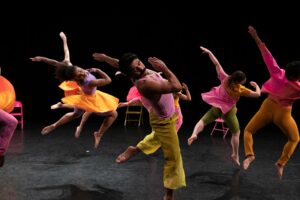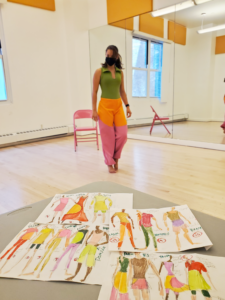Mark Morris’ “Look of Love” at TPAC
On June 28th and 29th, as part of their 2024 Dance Series, the Tennessee Performing Arts Center hosted the Mark Morris Dance Group for a performance of the Look of Love, a collection of choreographies by MMDG Artistic Director Mark Morris set to a jukebox collection of popular songs written by Burt Bacharach. The evening was saccharine, delightfully escapist, and featured wonderful performances of well-known tunes from a half century into the past.
Burt Bacharach was a hugely popular songwriter in the sixties, collaborating with lyricist Hal David to write hits that would be covered by over 1,000 artists who were a “who’s who” of mainstream popular music in the mid-sixties—B.J. Thomas, Dusty Springfield, Tom Jones, Dionne Warwick and many others. The music, typically described as the “Bacharach Sound” features intricately composed songs marked by frequently changing meters and surprising modulations coupled with irregular phrasing and novel instrumentation all packaged with a gentle female voice, innocent lyrics and a transparently clean production. In the age of Jimmy Hendrix, the Doors, and Deep Purple, the Bacharach sound was the mainstream antithesis of the era’s rock and psychedelic music.

Morris’ choreographies emphasized this seeming tension between appearance and structure with dances that appeared as simple expressions of the lyrics (when the song’s text mentions “pneumonia” the dancer pretends to sneeze, “I’ll Never Fall in Love Again”) while they were quite technically difficult—the seemingly random but carefully plotted avoidance of the rain in “Raindrops Keep Falling on My Head” and the constant marching in line around the stage without acknowledging each other in “Walk on By” were simple expressions that required needlepoint precision to pull off.
The dancers, all with remarkable posture and uplifting charisma, seemed to embody the limitless positivity of the evening. When they were dancing, the modernist style complemented by traditional techniques proved to be a slightly off-putting vehicle for constant positivity. My exposure to modern dance in Nashville is very often depicted within a social/political context with an intent for addressing a social wrong or challenge. This is a purpose that links Modern Dance to its origins. (I’m thinking here of recent productions by Oona Doherty, Fall, Alvin Ailey or even the Nashville Ballet). Further, the style’s emphasis, as the Oxford Encyclopedia’s article on the term describes it, is on “avoiding prettiness,” and seeking “…to discover the impact of emotion on the human body—ugly though the result may be.” This emphasis when aping lovelorn lamentation created a kind of dissonance in exaggerated expression onstage.
Other moments, especially in the lyric mimicry, were problematic. For example, when Dallas McMurray, whose technique was impeccable throughout the evening, lip-synced the words of “Message to Michael” as if he was in a classroom or lecture (or in a café somewhere) it was obvious and unnecessary. On the other hand, some of the weird worked wonderfully. The ensemble’s performance of the amorphous and delightful choreography to “The Blob” was stellar, complemented by Nicole Pearce’s lighting working with Isaac Mizrahi’s costumes to create a seemingly radioactive dance troupe. (Here for a moment or two I imagined that Morris was describing the creeping fear and division that has been spreading throughout society in recent years. It’s worth noting that I was doing all of this interpretive work and forcing this meaning—nothing onstage supported this reading.)

Mizrahi’s costumes, a non-binary collection of what seemed to be vintage space uniforms (think early Star Trek or Lost in Space) but colored like a variety pack of Kool-Aid flavors exemplified the bright positivity.
Again, the dancers themselves were wonderful. Special mention for charisma goes to Mica Bernas, Brandon Randolph and Christina Sahaida while Tennessee’s own Karlie Budge stood out with outstanding poise throughout the evening
The musical performance, like the danced performance, was astonishing. Marcy Harriell’s program biography emphasizes her “ability to passionately embrace diverse vocal styles” but her performance channeled Dionne Warwick in an excellent way. Clinton Curtis and Blaire Reinhard supported her in the background well too, especially at the moments of imitative counterpoint. Trumpeter Jonathan Finlayson deserves special mention for a wonderful tone with precise intonation.
At the end of the evening, thinking back to the evening’s performance of “Do You Know the Way to San Jose” made me remember when Jonathan Larson, in his “Santa Fe” from Rent, gently chided Bacharach’s confection. At the end of a song dreaming of abandoning artistic values and devoting work to “projects that sell,” Larson borrows Bacharach’s melody to have his Professor Tom Collins sing “Do you know the way to Santa Fe?” This criticism remains relevant—Bacharach’s (and Morris’) projects are projects that sell.
The Look of Love was written in a universe where the worst that can happen is your love is unrequited, and the best that can happen is a sunny day. In this way, Morris was remarkably dedicated and successful in visualizing “the Bacharach Sound.” While watching this a day after the most troubling Presidential debates in modern history provided a nice escape, it was no more than a trifle in too large of a serving–I think that dance can, and should, be more important than this.



